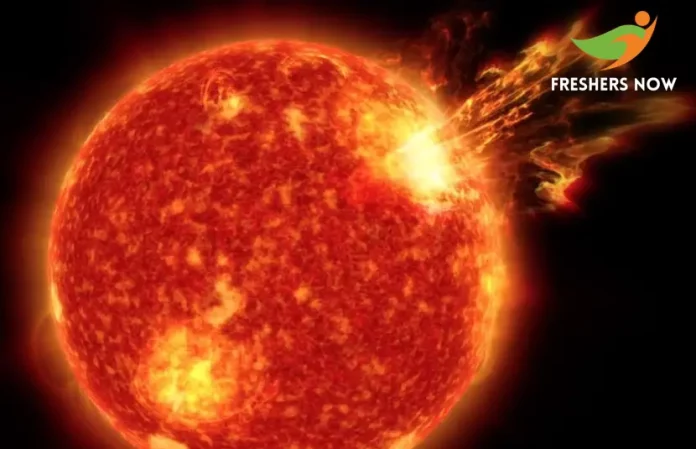
Sun Releases 2 Powerful Solar Flares, Earth In Firing Line: In the past week, the Sun has exhibited heightened activity, emitting two significant Solar flares from a newly identified sunspot, AR3663. These Solar flares, occurring within a short span of six hours, are part of the Sun’s 11-year magnetic cycle, which includes polar reversals.
Solar Flares: Causes and Intensity
Solar flares are powerful bursts of energy emitted from sunspots, temporary phenomena on the Sun’s surface. They result from the sudden release of magnetic energy due to changes in magnetic field lines near sunspots. Classified by intensity, solar flares range from the weakest (B-class) to the strongest (X-class).
Impact of Recent Flares
The first Solar flare, an X-class flare on 2nd May, caused widespread radio blackouts across Australia, Japan, and China. Following closely, an M-class flare struck on 3rd May. These events demonstrate the direct impact solar phenomena can have on Earth, especially when Earth faces active sunspots.
Coronal Mass Ejections (CMEs) and Their Effects
Solar flares may be accompanied by Coronal Mass Ejections (CMEs), involving the expulsion of plasma and magnetic fields into space. Earth-directed CMEs can disrupt power grids, telecommunications, and satellite operations, and pose radiation risks to astronauts in space.
Broader Implications and Monitoring
The dynamic and interconnected nature of celestial and terrestrial systems is highlighted by these solar events. Agencies like NASA continue to monitor solar activity closely to predict and mitigate the effects of solar emissions on our technology-dependent society.
Understanding Coronal Mass Ejection (CME)
Coronal Mass Ejections (CMEs) involve the release of plasma and magnetic fields from the Sun’s corona, the outer atmosphere. These ejections can influence Earth’s space weather significantly, causing solar storms, disrupting satellite operations, inducing electrical blackouts, and enhancing auroral displays.
The Sun’s Magnetic Field Cycle
The Sun undergoes an approximately 11-year magnetic cycle known as the solar cycle. This cycle includes the emergence and disappearance of sunspots, which correspond to areas of intense magnetic activity on the Sun’s surface. During this cycle, the Sun’s magnetic field becomes increasingly twisted and eventually reverses polarity.
Recent Solar Flares and Earth’s Vulnerability
Recent solar flares from sunspot region AR3663, including an X-class flare on 2nd May and an M-class flare on 3rd May, have heightened concerns about their potential impact on Earth. Sunspots like AR3663 are temporary phenomena that can emit powerful flares, causing disruptions in various communication and electrical systems.
Conclusion
As the Sun approaches the peak of its activity in the current solar cycle, vigilance is crucial. Solar flares and Coronal Mass Ejections (CMEs) have the potential to impact Earth’s technology and communication systems, highlighting the need for ongoing monitoring and preparedness. Understanding these solar phenomena allows us to better predict and mitigate their effects on our daily lives.
Stay updated with the latest current affairs and insightful blog posts by following FreshersNow.
| You Can Also Check | |
| Current Affairs | |



